|
|
From Bad to Good - Some Replacement Tips
Depending on the rock type, rock angle and crag ethics there are many variations of safe bolts and anchors that can be used. When rebolting routes the anchors installed must be designed to withstand repeated and heavy use for 50 years or more. Many of the old carrot bolts out there have been used for over 40 years already!
When many routes in Australia were first established, there was a lack of commercially available, certified bolts designed for rock climbing. Also, cost was often a factor for the 1980's, 90's, and 00's dirtbags, who often took a 'minimum effective dose' approach to bolting. Hence the carrot bolt. We now have standards for bolts (e.g. EN 959) and many commercially produced products subject to stringent testing and quality control, at reasonable prices and readily available. It is for this reason that Safer Cliffs Australia no longer endorses the use of homemade bolts, or hardware that does not conform to EN 959. Additionally, we believe that as part of any route rebolting process, steps should be taken to adopt and install hardware to current best-practice. From 2023 onwards, specifically, this means EN 959-compliant glue-in bolts, with epoxy injection glue. Unless there is a compelling case otherwise, expansion bolts should not be used for rebolting. Glue-in bolts have demonstrable superiority (see bolt types) and as of 2023 represent best-practice. There are crags in Spain where we see expansion bolt next to expansion bolt next to expansion bolt as they replace like with like endlessly instead of upgrading to a glue-in bolt that will last over 50 years without maintenance. Let's learn from their mistakes.
Cost should not be a decisive factor if you want to place bolts. The need to cut costs creates routes that are shoddily bolted with unsafe gear. As a general rule a five bolt sport route with an anchor will cost more than $90. If you cannot afford to pay this amount then do not even consider bolting new routes in Australia. This cost is why SCQ exists. We raise funds to help cover the costs of route maintenance for those few individuals kind enough to put in the hard work.
It is important to leave behind a quality job when rebolting.
Spend the time and invest in tools to remove the old bolts cleanly.
The aim is to extract the old bolt and reuse the hole for the
new bolt. A big crowbar or a 'carrot killer' device can remove
bash-ins with ease. A funkness device (hammer with chain of quickdraws)
can also extract problem bolts. If all else fails and you cannot
remove it cleanly then use a socket wrench with a big handle and
twist the head of the carrot off below the surface of the rock.
Do not use a chisel to 'chop' the bolt off. This creates ugly
exposed studs which can injure climbers who fall on them.
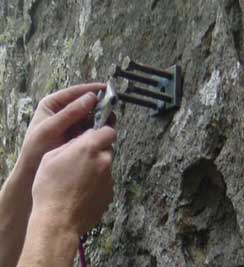 |
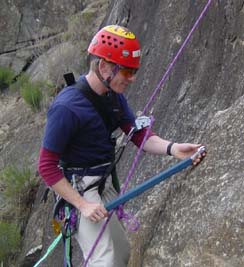 |
| Carrot Killer device. |
Wrench with bar to 'twist' off the head of a bolt. |
Patch and conceal all old holes and bolt scars. Epoxy putty is good for this job when mixed with sand from the base of the
route. If you cannot reuse the old bolt hole then place the new
bolt at minimum 100mm from the old hole.
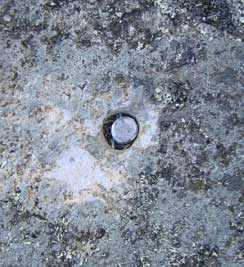 |
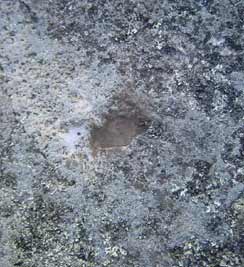 |
| Ugly chopped bolt scar |
Patched bolt scar with epoxy putty and dirt |
Bolts should be replaced on a bolt for bolt basis. Extra bolts (i.e. retrobolting)
should not be added unless you have permission from the first
ascensionist. It is not your
right to change the climb to make it ‘better’, ‘safer’
or ‘more user friendly’. Bolts may be slightly repositioned to improve the safety of clipping, or the positioning of quickdraws. Where the first ascentionist is uncontactable, a group discussion on the relevant local community forum will tell you if your ideas are the same as the general community.
In highly public areas bolts should be camouflaged with paint and glue
carefully embedded with appropriately coloured (usually light!) dirt around the entrance of the hole. Take care here - too much glue and dirt in efforts to camoflauge usually does the opposite. Remember - the glue lives INSIDE the hole, not on the rock around it. Ring bolts can be almost invisible if recessed properly. When recessing, ensure not to go so far as to create "biner-bind" where the carabiner cannot move freely. This could snap a carabiner.
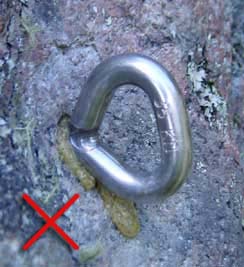 |
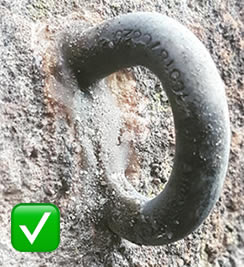 |
| An very obvious and ugly example of an unrecessed ringbolt. The messy glue from a capsule (also bad) is an eyesore. |
A camouflaged ringbolt that is well recessed. A mix of epoxy, metal paint and dirt was used to texture the outside of the bolt and the glue notch. Do this where visual impact may be an issue. |
Any anchor that may get high use as a lower off (rap chain) must be designed to be replaced easily when it wears through. Rap bolt anchors should not be added to climbs that did not have them originally unless it is to replace a sling, tree, piton or other unsafe anchor setup. Read our 2016 update on best practice guidelines for lower-off's!
Please try and avoid top-roping directly through anchors. If you
have to do so, run your ropes through your own carabiners –
not directly through the anchor. This will stop the anchor wearing
out prematurely. Only the last person should lower through the anchor directly.
|






